previously "SYNCHRON-ized Solo Strings"

This solo instruments collection of two violins, one viola, two cellos and one double bass is based on our extremely successful Collections VI Solo Strings I, Solo Violin 2 and Solo Cello 2, offering a completely overhauled sample database optimized for the Vienna Synchron Player. Our goal was to improve each instrument's playability and realism even more, which we achieved by enhancing the sample recordings as well as by utilizing the Synchron Player's unique features.
For Studio Solo Strings, our software developers added a specifically designed convolution reverb derived from Vienna MIR Pro to the Synchron Player, featuring the outstanding and unique ambience of the 540 m2 (5,813 sq.ft.) main hall of Vienna Synchron Stage. The perfectly engineered reverberation and placement presets combine customized impulse responses with expertly crafted reverb settings for each group of the ensemble. By adding the ambience of Vienna Synchron Stage's Stage A to the dry samples in real-time, Studio Solo Strings perfectly blend with any other product of our Synchron Series.
For each player, there are several Mixer Presets for solo and orchestral performances that depict different recording situations: Close, Classic, Distant, as well as settings without convolution but short and long reverb. In the solo Mixer Presets, you can also select the position of your players (left, center, right).
The Patches of the basic Presets are organized according to basic playing style or Articulation, e.g., short notes or dynamics. These slots may again contain subtypes (spiccato, staccato, …), with further options if available.
Articulations are disabled by default. Enabling an Articulation means that all the Types contained will be activated, too, so if you happen to be short of RAM it is advisable only to activate what you really need (you can always add more Types later).
Keyswitches and controllers
By default the keyswitches for Articulations are mapped starting with C1 (for Middle C = C4) for violin, viola, and cello, and C5 to G#5 for double bass. For the available Types, the keyswitches start from C2 for violin and viola, and from C7 for cello and bass.
Additional options within Articulations or Types are offered by the Dimension Controllers. The controller function is indicated by the respective caption, as of course it may take on different tasks as needed.
Ranges
The maximum play ranges of the instruments are:
- Violin 1 G3–A#7
- Violin 2 G3–G7
- Viola C3–G#6
- Violoncello 1 C2–F6
- Violoncello 2 C2–D6
- Double bass B0–G4
These may be less depending on articulation (e.g., harmonics).
Spiccato, staccato, short détaché, long détaché with vibrato, and legato repetitive notes.
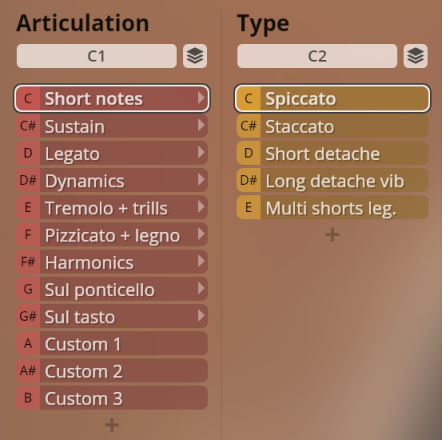
Sustained notes without and with normal, progressive, and decreasing vibrato.
Vibrato XFade control: Dim.Ctrl/A (CC1, modwheel).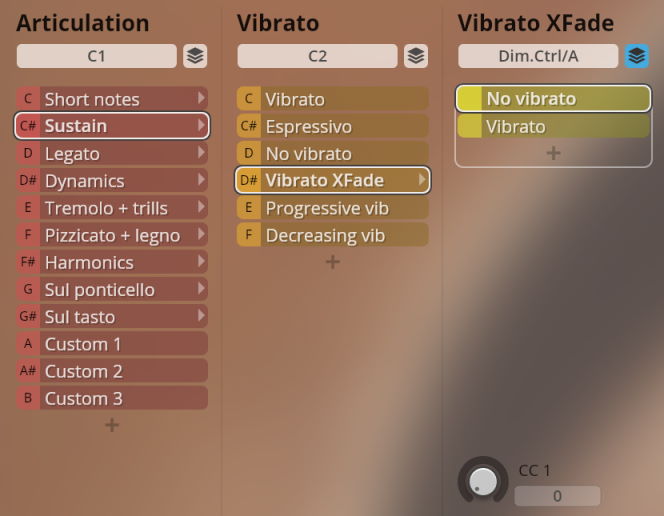
Performance legato and marcato regular and fast with auto-speed option, legato with progressive vibrato, and portamento.
Auto-speed control: Dim.Ctrl/C (playing speed).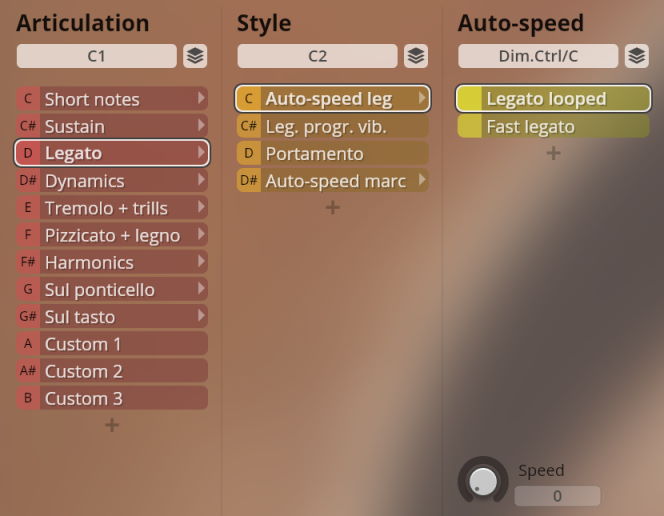
Sforzato, fortepiano, and sforzatissimo.

Tremolo regular and with sustain crossfading option, half and whole tone trills.
Sustain/tremolo XFade control: Dim.Ctrl/A (CC1, modwheel).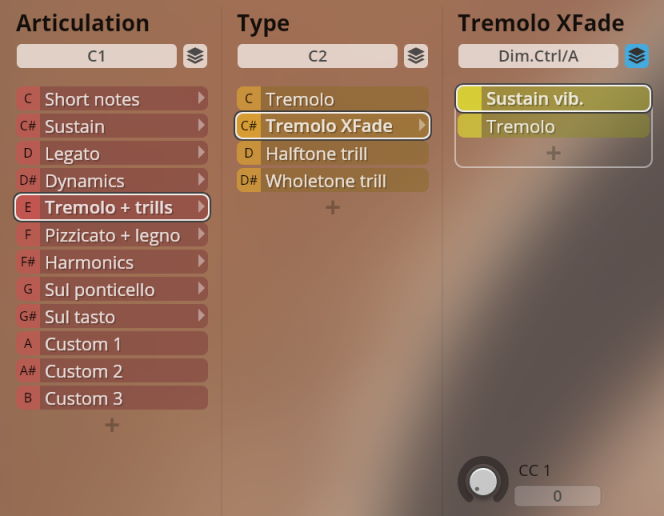
Pizzicato, snap pizzicato, and col legno.
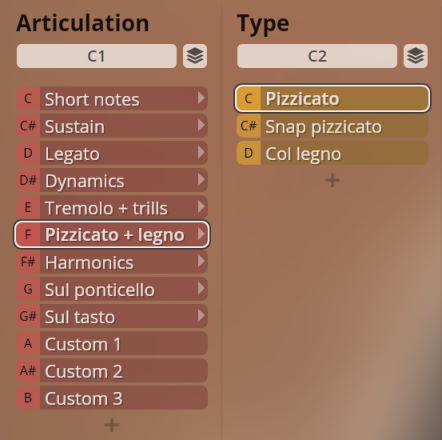
Harmonics, staccato and sustained.
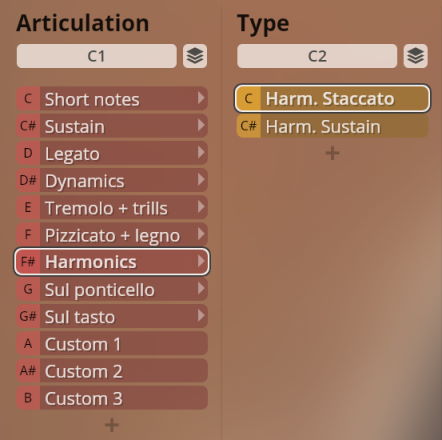
Ponticello staccato, legato, sforzato, and tremolo.

Sul tasto staccato, legato, sforzato, and tremolo.
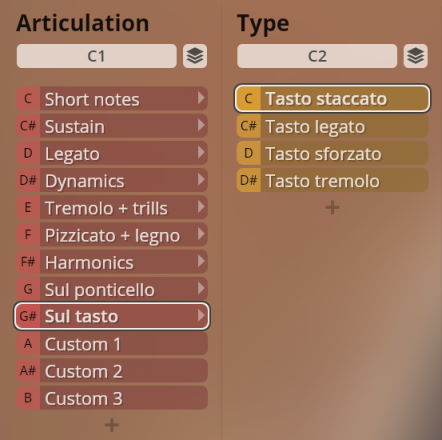
Staccato and legato repetitive notes, staccato, short détaché, and long détaché with vibrato.
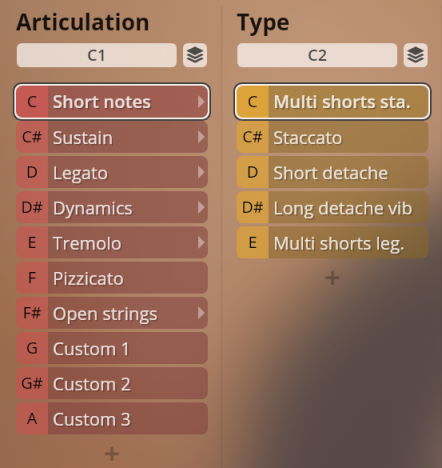
Sustained notes with and without vibrato, with crossfading option, and with progressive vibrato. Normal vibrato is doubled in the second slot to keep the layout consistent with the other instruments.
Vibrato XFade control: Dim.Ctrl/A (CC1, modwheel).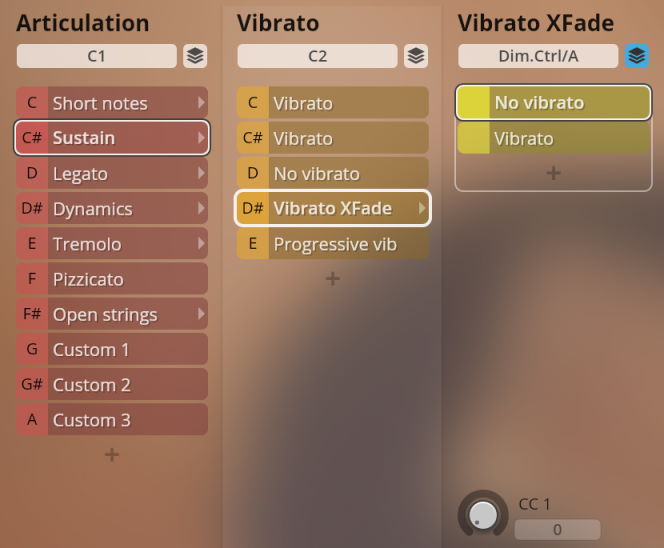
Legato and performance trills with auto-speed control, legato with progressive vibrato, and portamento.
Auto-speed control: Dim.Ctrl/C (playing speed).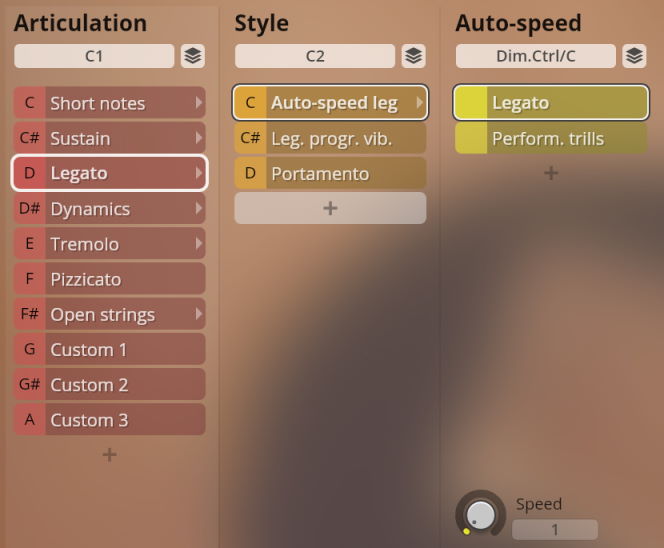
Sforzato, fortepiano, and sforzatissimo.

Tremolo regular and with sustain crossfading option.
Sustain/tremolo XFade control: Dim.Ctrl/A (CC1, modwheel).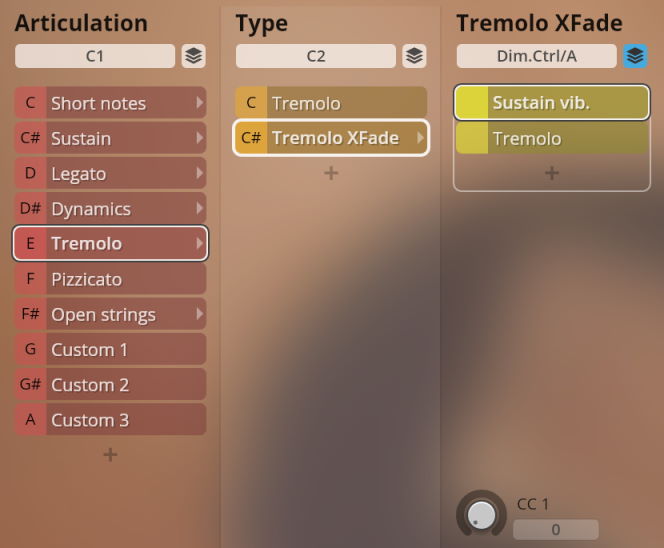
Pizzicato, no further options.
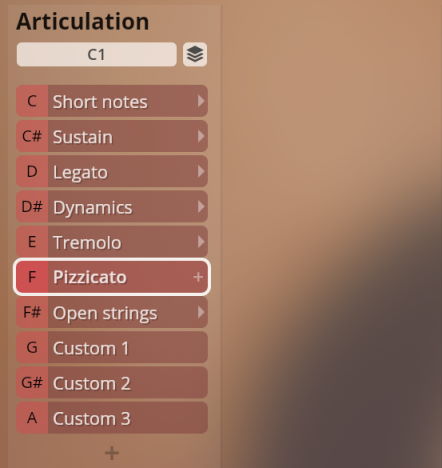
Staccato, sustained, sforzato, and tremolo, played using open instead of fingered strings for the respective notes.

The Full Presets comprise all the available Articulations of the respective instrument. Naturally, these Presets take up more RAM than their Basic counterparts.
Keyswitches and controllers
The keyswitches for category (Single notes, Multi shorts, etc.) are mapped starting with C1 (for Middle C = C4) for violin, viola, and cello, and C6 for double bass. Within these categories, subdivisions such as type of single notes are controlled by keyswitches starting from F1/F6. Additional options within Articulations or Types are offered by the Dimension Controllers, which may be keyswitches or MIDI controllers. The controller function is indicated by the respective caption, as of course it may take on different tasks as needed.
Short notes
Staccato, short and long détaché, and performance spiccato and détaché, both of which offer further options.
Articulation keys: from C2/C7.- Performance spiccato: Regular and fast as well as with auto-speed option, and harsh.
- Type keys: from F2/F7
- Auto-speed control: Dim.Ctrl/C (playing speed)
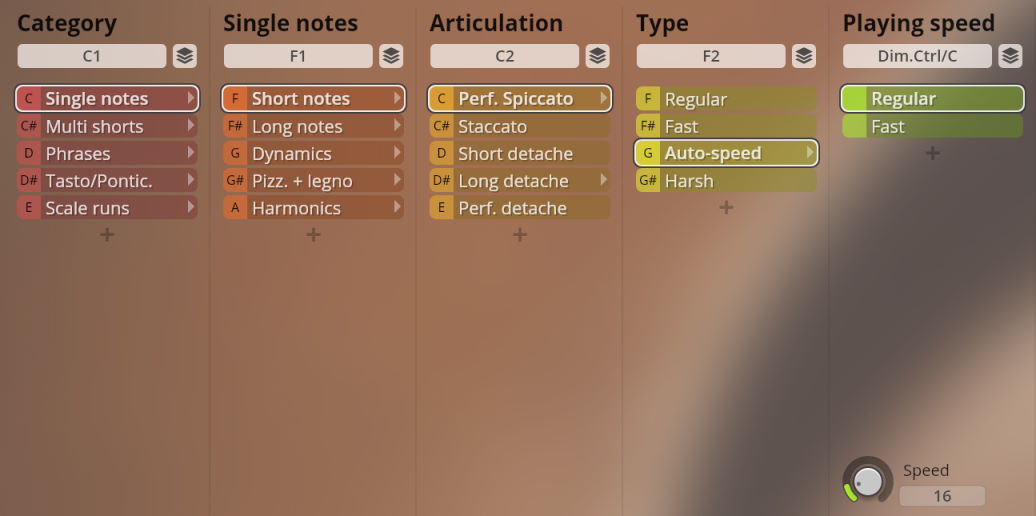
- Long détaché: Long détache with and without vibrato, and with a crossfading option.
- Vibrato selection: Dim.Ctrl/A (CC1, modwheel).
- Vibrato XFade control: Dim.Ctrl/B (CC20).
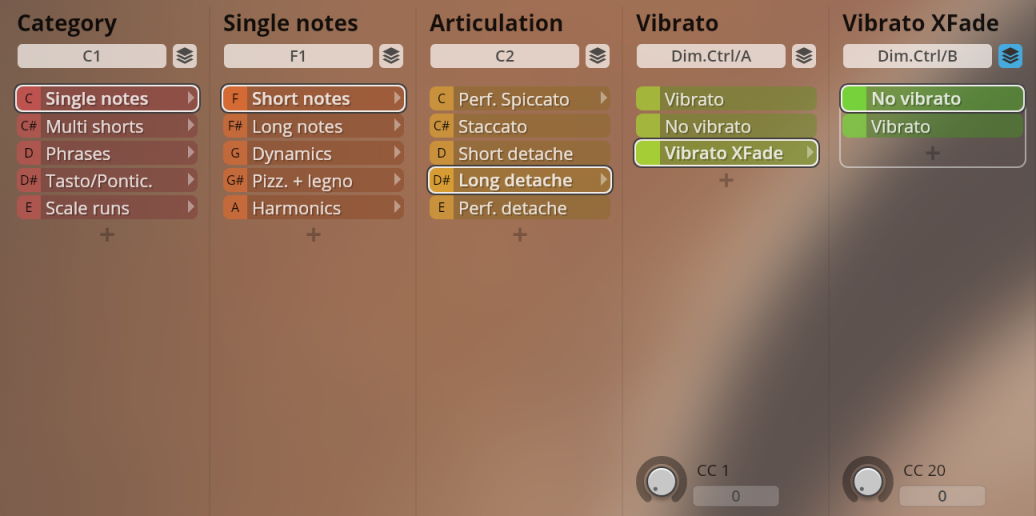
Long notes
Sustain, legato, portamento, and marcato with soft attack, normal, marcato, and flautando.
- Sustain: Sustained notes without and with progressive and decreasing vibrato, espressivo, and with a vibrato/no vibrato crossfading option.
- Vibrato selection: Dim.Ctrl/A (CC1, modwheel).
- Vibrato XFade control: Dim.Ctrl/B (CC20).
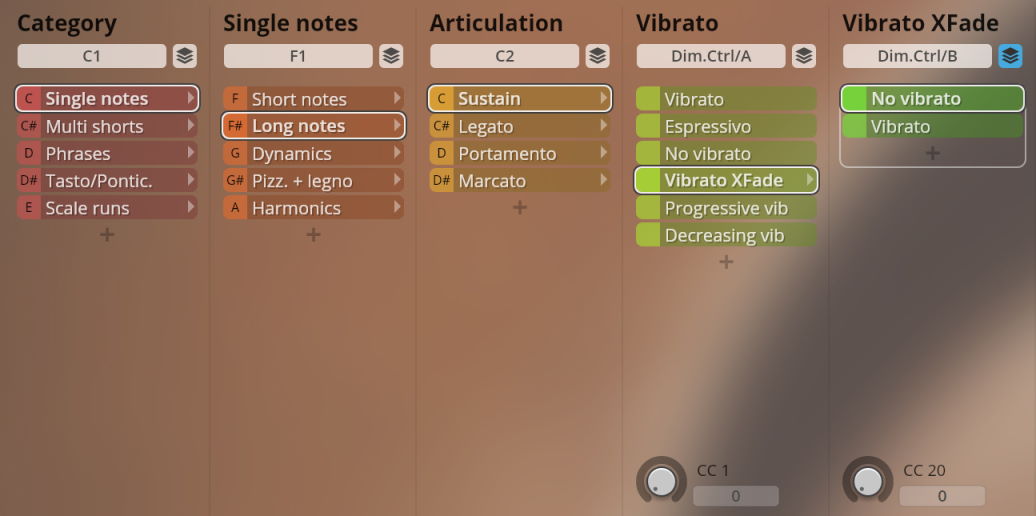
- Legato: Legato with looped and unlooped samples, fast legato, performance trills, and auto-speed options for legato and trills.
- Legato type keys: from E2/E7.
- Looped: The looped legato offers a vibrato variety and a crossfading option with sustains without vibrato.
- Vibrato selection: Dim.Ctrl/A (CC1, modwheel).
- Vibrato XFade control: Dim.Ctrl/B (CC20).

- Unlooped: Unlooped legato articulations with normal and progressive vibrato, and sulla corda.
- Vibrato selection: Dim.Ctrl/A (CC1, modwheel).

- Auto-speed: Speed-controlled switching between looped and fast legato, and looped legato and performance trills.
- Auto-speed control: Dim.Ctrl/C (playing speed).

- Portamento: Regular and zigane style portamento.
- Type keys: from F2/F7.

- Marcato: Performance marcato normal and fast with auto-speed option, and marcato sustained.
- Type keys: from F2/F7.
- Auto-speed: Speed-controlled switching between normal and fast marcato.
- Auto-speed control: Dim.Ctrl/C (playing speed).

- Marcato sustain: Stacked vibrato sustain and espressivo Articulations.
- Vibrato/espressivo switch: Dim.Ctrl/A (CC1, modwheel).
Dynamics
Accents, soft and strong dynamics, and piano-forte-piano.
- Accents: Sforzato, fortepiano, and sforzatissimo, sforzato and fortepiano with crescendo option.
- Accent keys: from F2/F7.
- Regular:

- Crescendo: Sforzato and fortepiano layered with 4.5 sec. crescendo.

- Soft/strong dynamics: Soft dynamics 1.5/3/4.5 sec., 1.5 and 3 sec. with and without vibrato and crossfading option; strong dynamics 1.5/3/5.5 sec.
- Vibrato selection: Dim.Ctrl/A (CC1, modwheel).
- Vibrato XFade control: Dim.Ctrl/B (CC20).
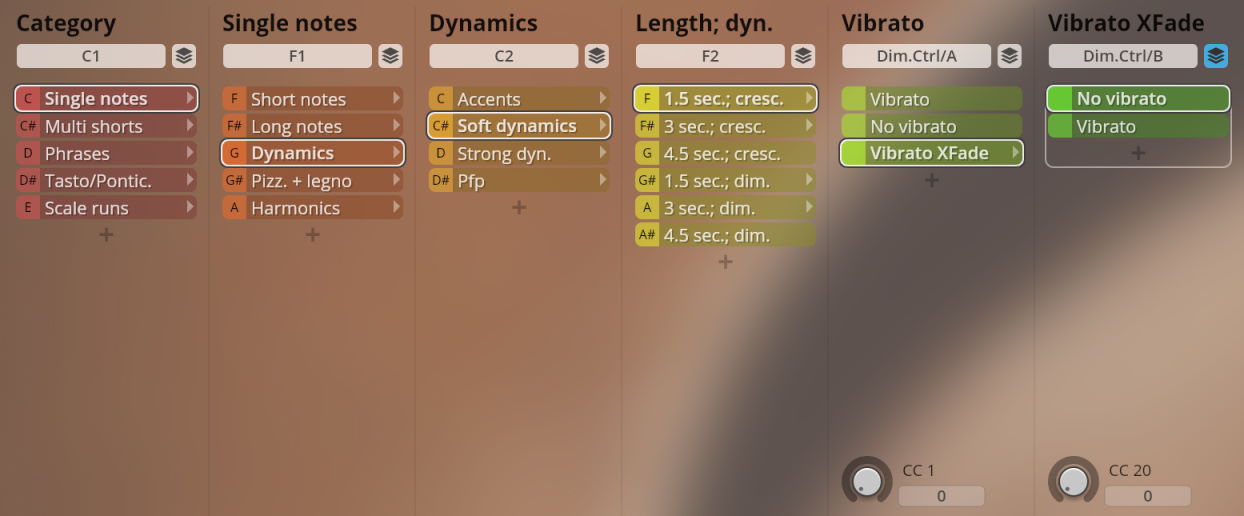
- pfp Pfp 3 and 6 sec.

Pizzicato and col legno
Pizzicato normal and secco, snap pizzicato; col legno.
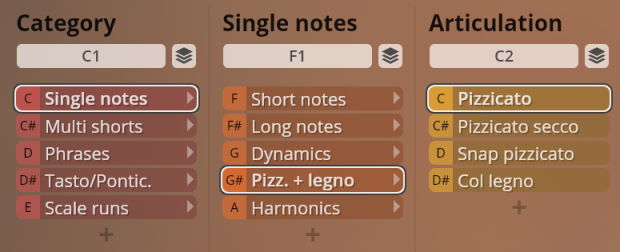
Harmonics
Artificial and natural harmonics.
- Artificial harmonics: Sustained, détaché, and staccato.
- Note length keys: from F2/F7.

- Natural harmonics: Sustained, détaché, and glissando up and down.
- Type keys: from F2/F7.

Various repetition performances; violin 1 and violoncello 1 offer Articulations with and without bow changes.
- Bow change keys: F1/G1 resp. F7/G7.
Bow changes
Legato slow and fast, portato, staccato, spicdato, and spiccato harsh. Violin 1 offers three portato speeds.
Articulation keys: from C2/C7.
Legato slow and fast, portato slow and medium:
Regular and dynamic repetitions (5 repetitions), with a dynamic layer option. The slow and medium portato Articulations are only offered by Violin 1.Regular/dynamic keys: from A2/A7.
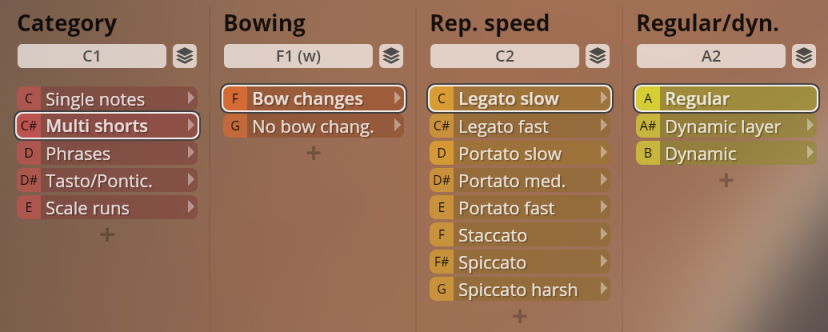
- Dynamic layers: Dynamic layer switch: Dim.Ctrl/A (CC1, modwheel).
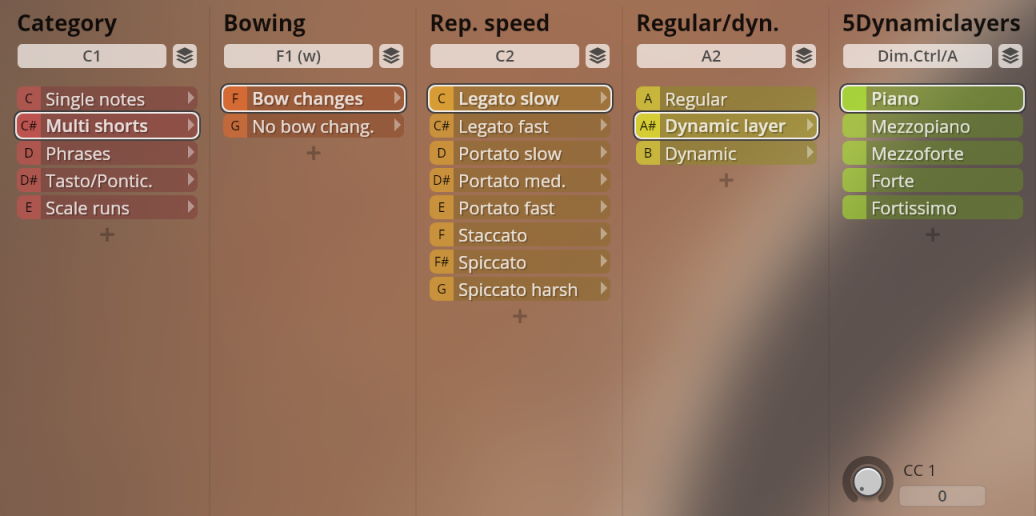
- Dynamics: Cre/dim keys: A0/B0 resp. A5/B5.

- Portato (fast), staccato, spiccato, spiccato harsh: Regular and dynamic repetitions (9 repetitions), with a dynamic layer option.
- Regular/dynamic keys: from A2/A7.
- Cre/dim keys: A0/B0 resp. A5/B5.
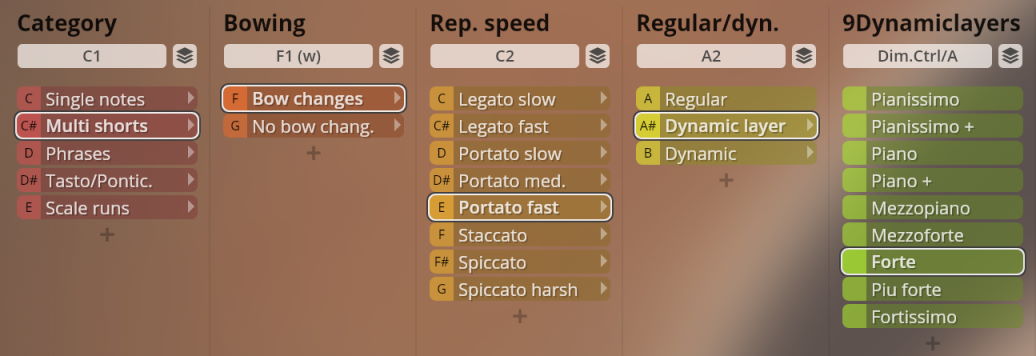
No bow changes
Slow and fast repetitions, regular and dynamic. These are only offered by Violin 1 and Violoncello 1.
- Slow/fast keys: from C2/C7.
- Regular/dynamic keys: from A2/B2 resp. A7/B7.
- Cre/dim keys: A0/B0.

Tremolo, fast repetitions, half and whole tone trills, glissando, and grace notes.
- Phrase keys: F1/F7.
Tremolo
Tremolo regular, as well as long and short tremolo dynamics.
- Regular/dynamics keys: from C2/C7.
- Regular tremolo: Tremolo with regular and fast attack with normal and cut release.
- Attack keys: from A0/A5.
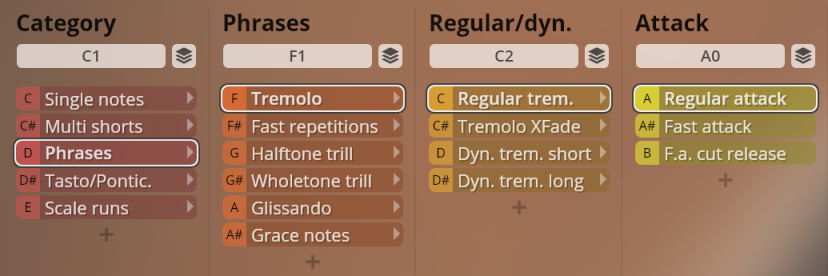
- Tremolo Xfade: Crossfading option between vibrato sustain and tremolo.
- XFade control: Dim.Ctrl/A (CC1, modwheel).
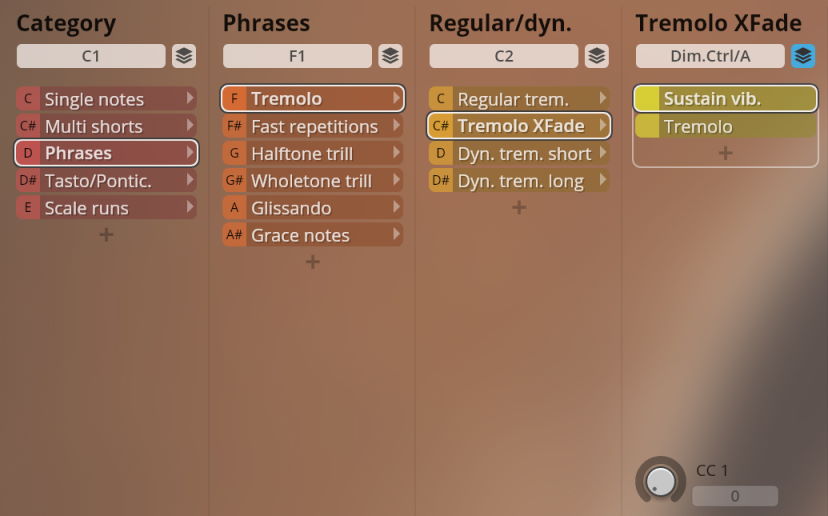
- Tremolo dynamics: Short and long crescendo and diminuendo.
- Cre/dim keys: A0/B0 resp. A5/B5.
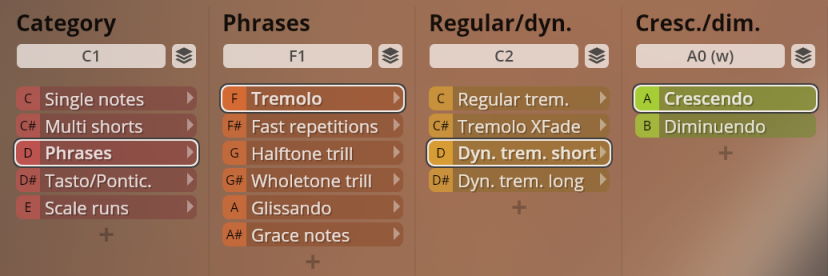
Fast repetitions
Long, short, and dynamic repetitions at speeds from 140 to 200 BPM (according to instrument), ricochet repetitions from 150 to 210 BPM, and ricochet specials.
- Regular/dynamics keys: from C2/C7.
- Long/short repetitions, ricochet: Regular repetitions resp. ricocvhet with normal and cut release.
- Tempo keys: from F2/F7.
- Note/cut release keys: A0/B0 resp. A5/B5.

- Dynamics repetitions: Crescendo and diminuendo repetitions.
- Tempo keys: from F2/F7.
- Cres/dim keys: A0/B0 resp. A5/B5.

- Ricochet specials: Three repetitions, accelerando and ritardando ricochets.
- Type keys: from F2/F7.
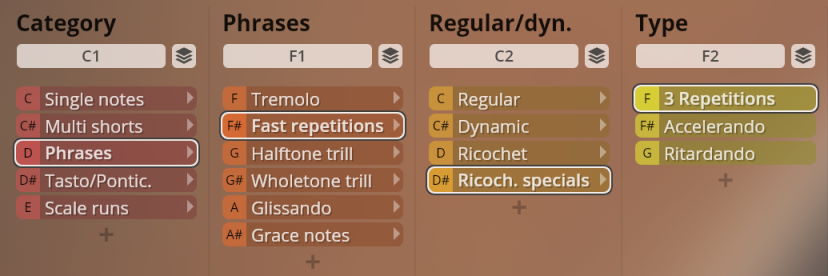
Half and whole tone trills
Regular and dynamic trills, normal (with note and cut release) and accelerando.
- Regular/dynamics keys: from C2/C7.
- Note/cut release keys: A0/B0 resp. A5/B5.
- Cre/dim keys: A0/B0 resp. A5/B5.
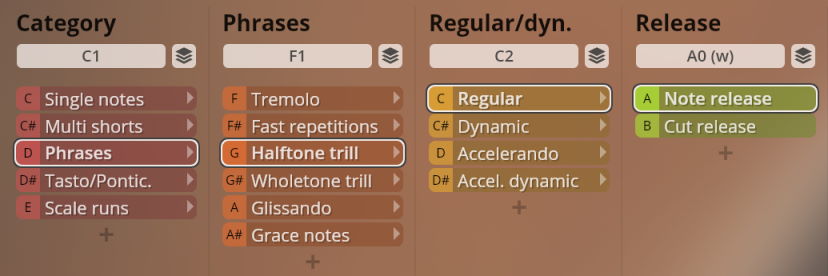
Glissando
Octave glissando up and down, slow and fast (Viola: one speed only), and performance glissandos on each string (Double bass: only one performance glissando).
- Glissando type keys: from C2/C7.
- Up/down keys: A0/B0 resp. A5/B5.
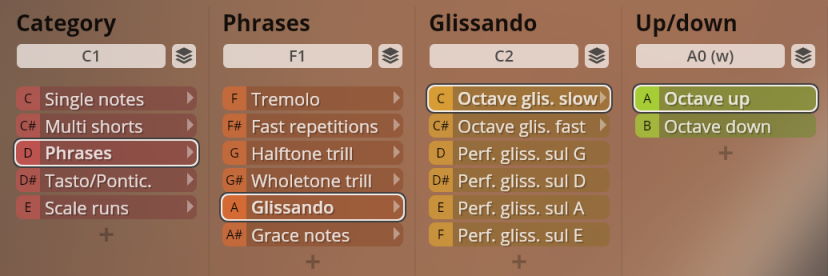
Grace notes
Grace notes regular, half and whole tone, and zigane style, half tone to major third, up and down (all except double bass). Violin 1 also offers slow and fast variants of the regular
- Grace note keys: C2/D2 resp. C7/D7. Violin 1: C2–D2 slow–fast–zigane.
- Interval keys: from F2/F7.
- Up/down keys: A0/B0 resp. A5/B5.
- Regular:

- Zigane:

Articulations sul tasto and ponticello, and crossfading between tasto, regular, and ponticello articulations.
- Tasto/ponticello/XFade keys: from F1/F7.
Sul tasto
Staccato, détaché, sustained, legato, tremolo with regular and fast attack (also with cut release), and sforzato.
- Articulation keys: from C2/C7.
- Tremolo attack keys: from A0/A5.
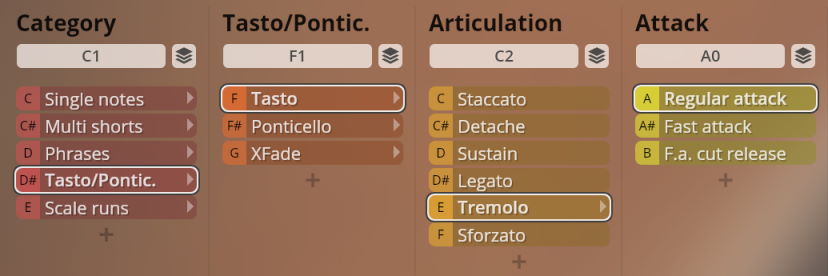
Ponticello
Staccato, détaché, sustained, legato, tremolo with regular and fast attack (also with cut release), sforzato, sforzatissimo, legato repetitions normal and dynamics.
- Articulation keys: from C2/C7.
- Tremolo attack keys: from A0/A5.

XFade
This Slot provides crossfading between sul tasto, regular, and ponticello Articulations. (Sffz and repetitions: regular and ponticello only.)
- Articulation keys: from C2/C7.
- Tremolo attack keys: from A0/A5.
- Playing position control: Dim.Ctrl/A (CC1, modwheel).

Legato and spiccato scale runs, major and minor for every key, major and harmonic minor, chromatic and whole tone, up and down. Please note that the mapping of starting notes follows the respective major or minor scale.
- Scale runs keys: from F1/F7.
- Key/scale keys: from C2/C7.
- Up/down keys: A0/B0 resp. A5/B5.
Major / minor runs

Special runs
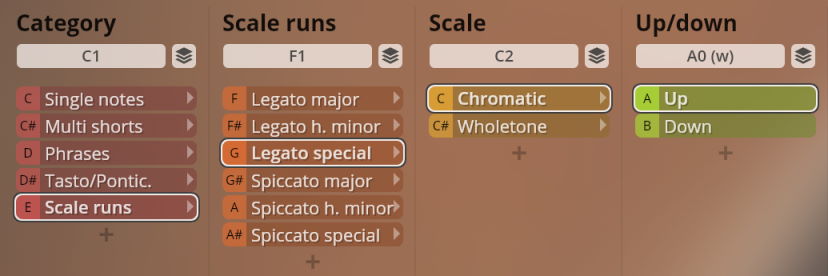
Violin 2 and Violincello 2 offer their Articulations played with or without open strings.
- No open string/open string keys: A0/B0.
Short notes
Staccato, short détaché, and long détaché with and without vibrato, also with crossfading option.
- Articulation keys: from C2/C7.
- Staccato, short détaché:
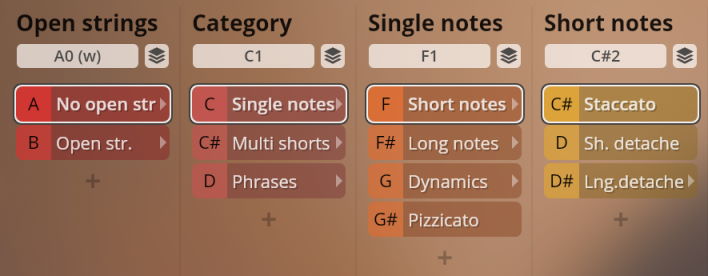
- Long détaché:
- Vibrato selection: Dim.Ctrl/A (CC1, modwheel).
- Vibrato XFade control: Dim.Ctrl/B (CC20).
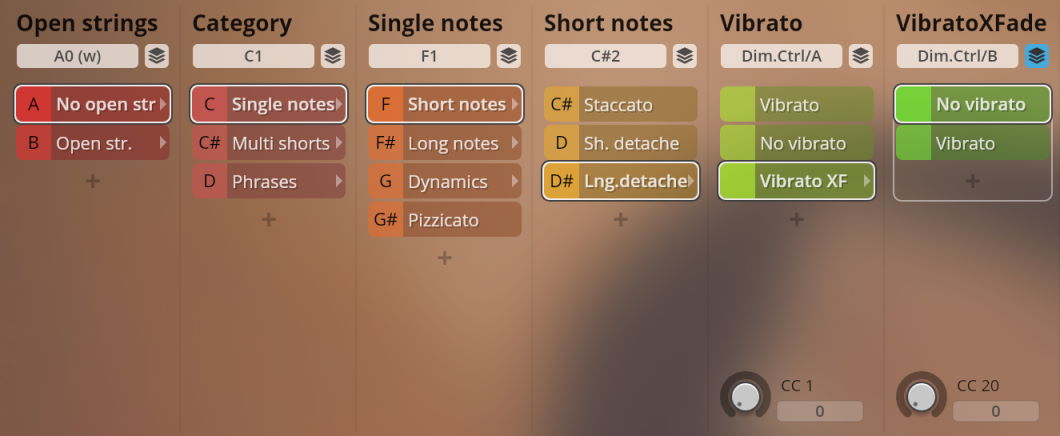
Long notes
Sustain, legato, portamento, and marcato with soft attack, normal, marcato, and flautando.
- Sustain, portamento: Sustained notes and portamento without, with normal and progressive vibrato, and with vibrato/no vibrato crossfading options.
- Vibrato selection: Dim.Ctrl/A (CC1, modwheel).
- Vibrato XFade control: Dim.Ctrl/B (CC20).
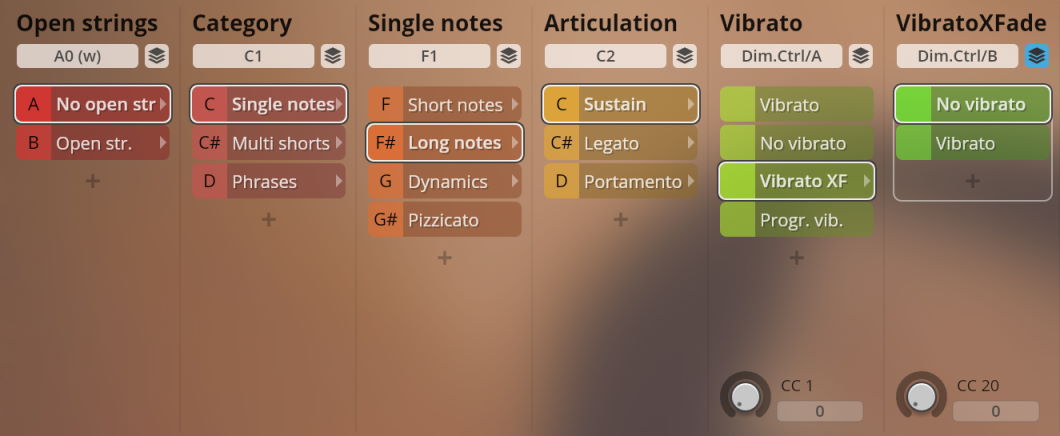
- Legato: Legato without, with normal and progressive vibrato, performance trills, and and auto-speed option for legato and trills.
- Legato type keys: from F2/F7 (white keys only).
- Vibrato selection: Dim.Ctrl/A (CC1, modwheel).
- Vibrato XFade control: Dim.Ctrl/B (CC20).

- Auto-speed: Speed-controlled switching between legato and performance trills.
- Auto-speed control: Dim.Ctrl/C (playing speed).
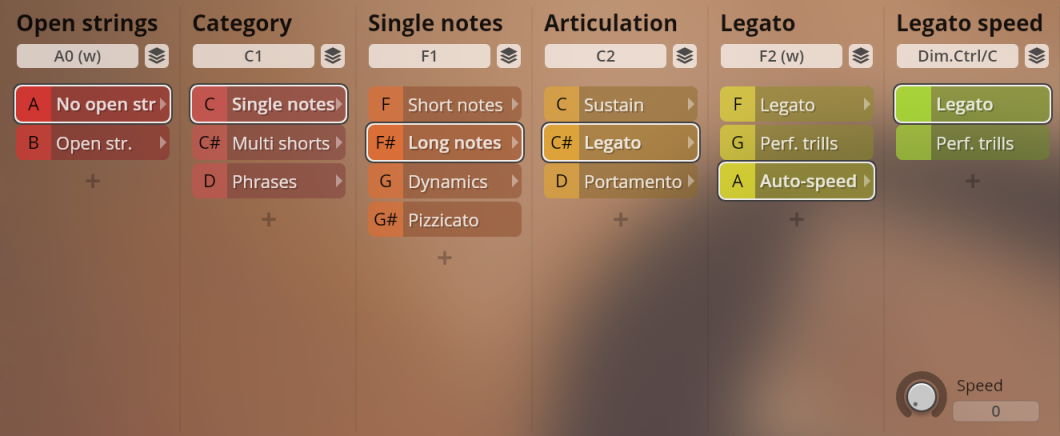
Dynamics
Accents, soft and strong dynamics, and piano-forte-piano. All Articulations with and without vibrato.
- Dynamics keys: from C2/C7.
- Vibrato selection: Dim.Ctrl/A (CC1, modwheel).
- Accents: Sforzato, fortepiano, and sforzatissimo, sforzato and fortepiano with crescendo option.
- Type keys: from F2/F7.
- Regular: Vibrato XFade control: Dim.Ctrl/B (CC20).
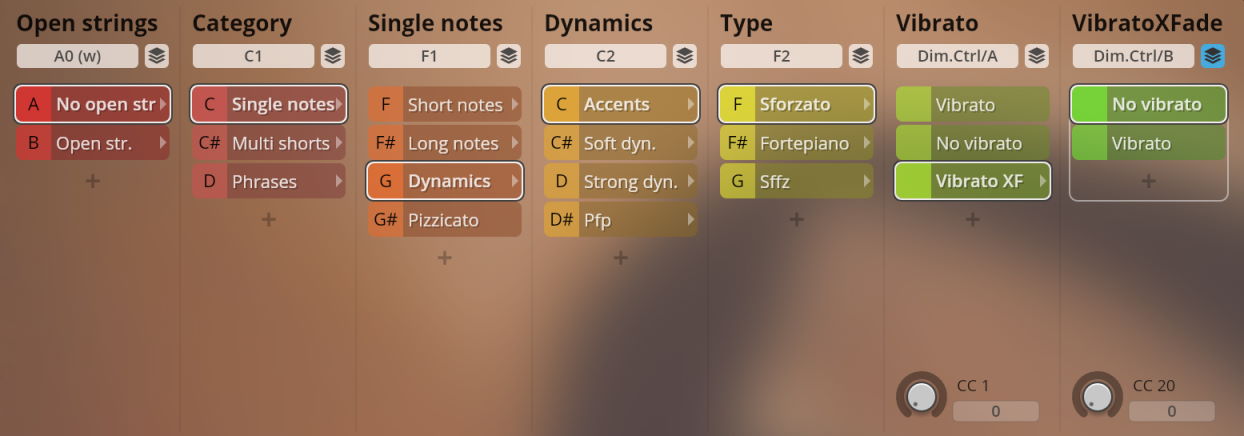
- Sfz and fp crescendo: A stacked Articulation with a sforzato attack blending into a crescendo note.

- Soft and strong dynamics, pfp Soft crescendo and diminuendo 1.5/3/4 sec., strong crescendo and diminuendo 2/3/4 sec., and pfp 2/4/6 sec., with and without vibrato.
- Vibrato XFade control: Dim.Ctrl/B (CC20).
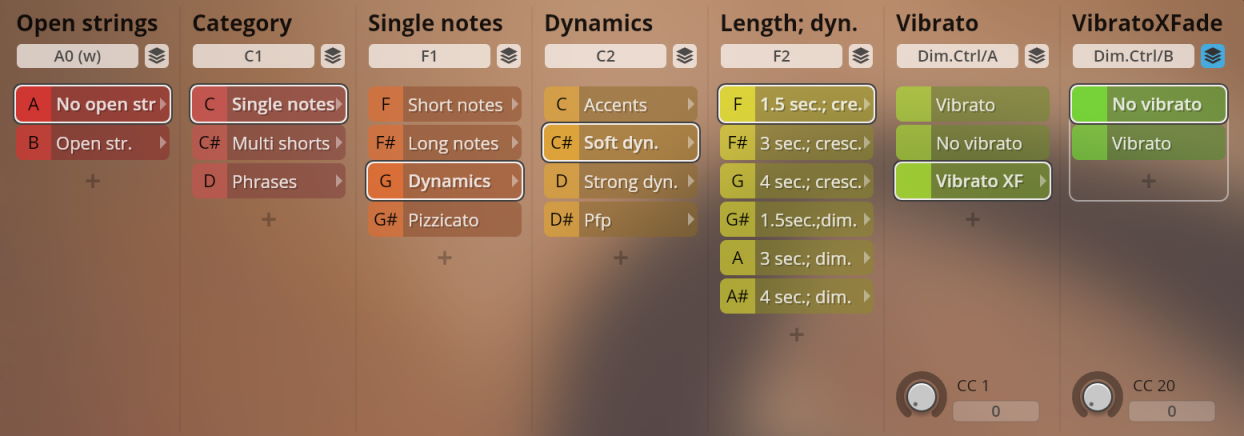
Pizzicato
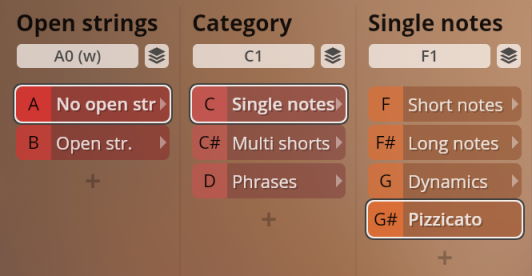
Repetition performances legato with and without vibrato, portato, staccato, normal and crescendo; legato also offers a vibrato crossfading option.
- Repetition speed keys: from C2/C7 (white keys only).
- Regular/crescendo keys: A2/B2 resp. A7/B7.
Legato
- Vibrato selection: Dim.Ctrl/A (CC1, modwheel).
- Vibrato XFade control: Dim.Ctrl/B (CC20).
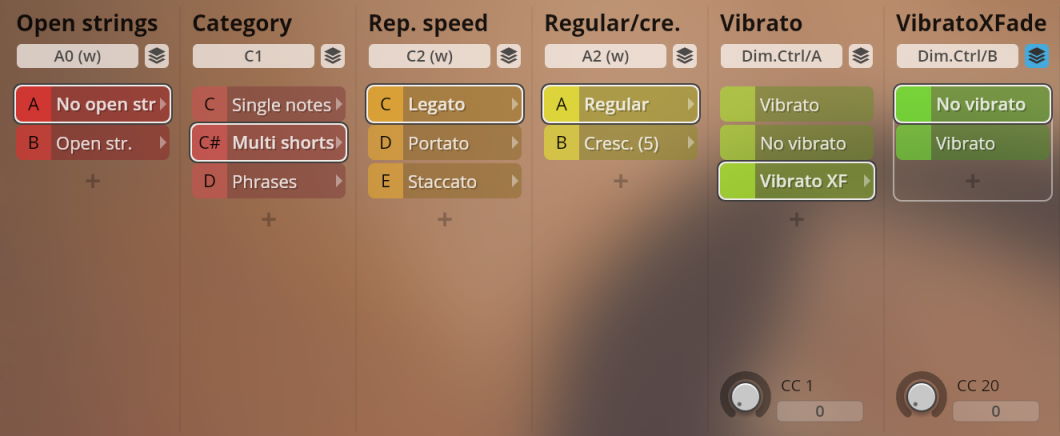
Portato, staccato

Tremolo and fast repetitions.
- Phrase keys: F1/F#1 resp. F7/F#7.
Tremolo
Tremolo regular, with a vibrato sustain crossfading option.
- Sustain/tremolo XFade control: Dim.Ctrl/A (CC1, modwheel).
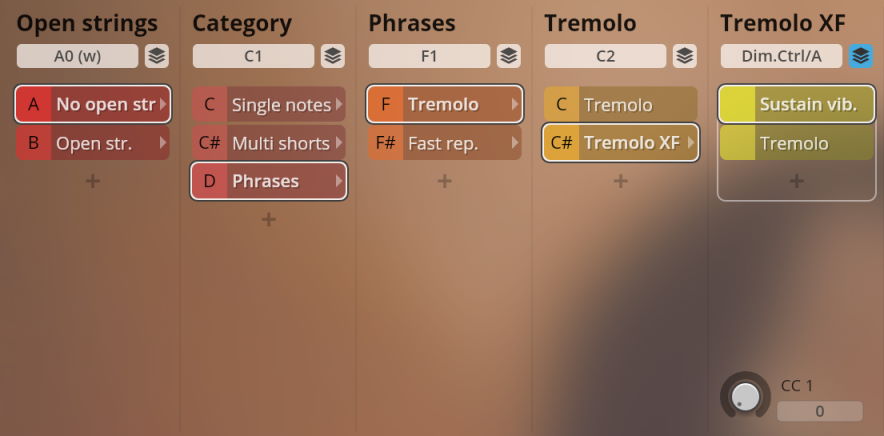
Fast repetitions
Fast staccato repetitions with 140/150/160/170/180/200 BPM.
- Tempo keys: from F2/F7.

